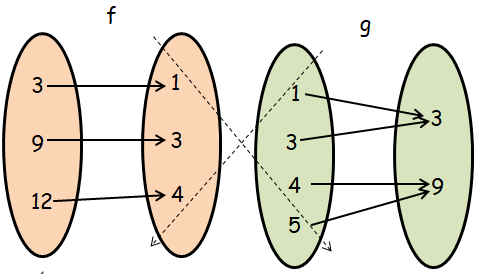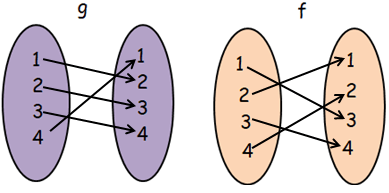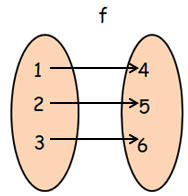HOW TO FIND FOG AND GOF FROM THE GIVEN RELATIONS F AND G
Subscribe to our ▶️ YouTube channel 🔴 for the latest videos, updates, and tips.
To find fog and gof from the given relations f and g, we may have to follow the procedure given below.
Step 1 :
When each relation is given in the form of set of ordered pairs. Represent each relation f and g as arrow diagram.
Step 2 :
To understand the composition better, let us consider the example.
f(0) = 1 and g(1) = 3
Then,
fog(0) = 3
Here 0 is associated with 1 in the function f. 1 is associated with 3 in the function g. Then fog(0) will be 3.
Problem 1 :
Let f = {(3, 1), (9, 3), (12, 4)} and g = {(1, 3) (3, 3) (4, 9) (5, 9)}
Show that gof and fog are defined. Also find fog and gof.
Solution :


Finding composition of function f o g :

fog(x) = f[g(x)]
From g, when x = 1
- f[g(1)] = f[3] ==> 1, then (1, 1)
From g, when x = 3
- f[g(3)] = f[3] ==> 1, then (3, 1)
From g, when x = 4
- f[g(4)] = f[9] ==> 3, then (4, 3)
From g, when x = 5
- f[g(5)] = f[9] ==> 3, then (5, 3)
fog = { (1, 1), (3, 1), (4, 3), (5, 3) }
Finding composition of function g o f :

gof(x) = g[f(x)]
From f, when x = 3
- g[f(3)] = g[1] ==> 3, then (3, 3)
From f, when x = 9
- g[f(9)] = g[3] ==> 3, then (9, 3)
From f, when x = 12
- g[f(12)] = g[4] ==> 9, then (12, 9)
gof = { (3, 3) (9, 3) (12, 9) }
Problem 2 :
Let f = { (1, -1) (4, -2) (9, -3) (16, 4) }
and
g = { (-1, -2) (-2, -4) (-3, -6) (4, 8) }
Show that gof is defined while fog is not defined. Also find gof.
Solution :


Finding composition of function g o f :

gof(x) = g[f(x)]
From f, when x = 1
- g[f(1)] = g[-1] ==> -2, then (1, -2)
From f, when x = 4
- g[f(4)] = g[-2] ==> -4, then (4, -4)
From f, when x = 9
- g[f(9)] = g[-3] ==> -6, then (9, -6)
From f, when x = 16
- g[f(16)] = g[4] ==> 8, then (16, 8)
gof = { (1, -2) (4, -4) (9, -6) (16, 8) }
Finding composition of function f o g :

fog(x) = f[g(x)]
From g, when x = -1
- f[g(-1)] = f[-2]
There is no input -2 in the relation f. So, the function fog is not defined.
Problem 3 :
If
f = {(1,3) (2,1) (3,4) (4,2)}
and
g = {(1,2) (2,3) (3,4) (4,1)}
then find n(fog)
Solution :


Finding composition of function f o g :

fog(x) = f[g(x)]
From g, when x = 1
- f[g(1)] = f[2] ==> 1, then (1, 1)
From g, when x = 2
- f[g(2)] = f[3] ==> 4, then (2, 4)
From g, when x = 3
- f[g(3)] = f[4] ==> 2, then (3, 2)
From g, when x = 4
- f[g(4)] = f[1] ==> 3, then (4, 3)
fog = { (1, 1), (2, 4) (3, 2) (4, 3) }
Number of ordered pairs in fog :
n[fog] = 4
Problem 4 :
If
f = {(1, 4), (2, 5), (3, 6)} and g = {(4, 8), (5, 7), (6, 9)}
then gof is
a) { } b) {(1,8), (2, 7), (3, 9)}
c) {(1,7), (2, 8), (3, 9)} d) {(1,8), (2, 5), (3, 9)}
Solution :


Finding composition of function g o f :

gof(x) = g[f(x)]
From f, when x = 1
- g[f(1)] = g[4] ==> 8, then (1, 8)
From f, when x = 2
- g[f(2)] = g[5] ==> 7, then (2, 7)
From f, when x = 3
- g[f(3)] = g[6] ==> 9, then (3, 9)
fog = { (1, 8), (2, 7) (3, 9) }
So, option b is correct.
Subscribe to our ▶️ YouTube channel 🔴 for the latest videos, updates, and tips.
Recent Articles
-
Finding Range of Values Inequality Problems
May 21, 24 08:51 PM
Finding Range of Values Inequality Problems -
Solving Two Step Inequality Word Problems
May 21, 24 08:51 AM
Solving Two Step Inequality Word Problems -
Exponential Function Context and Data Modeling
May 20, 24 10:45 PM
Exponential Function Context and Data Modeling